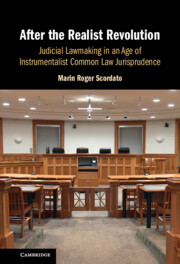 After the Realist Revolution
After the Realist Revolution Understanding the Purpose and Function of Causation in Tort Law
Published online by Cambridge University Press: 02 May 2025
This chapter offers an example of conceptual instrumentalist analysis. Being instrumentalist in nature, the analysis focuses on the degree to which one plausible doctrinal design or another best advances the underlying social policies sought to be achieved in a given area of law. Unlike classic empirical analysis, however, the social policies at play in conceptual instrumentalist analysis are not concrete practical benefits that might be furthered in the real world, like greater compensation or deterrence, but are instead more abstract preferred outcomes, like greater fairness or the presence of sufficient fault by a certain party before the imposition of legal liability. Of course, appellate court analysis of any particular legal issue might involve elements of both empirical and conceptual instrumentalist analysis.
The focus of the analysis in this chapter is the tort law requirement of causation. The account presented seeks to explain the structure of this long-standing requirement, the meaning ascribed to the distinction between actual and proximate cause, and the rationale underlying the various exceptions to the main rule that have been developed over time.
To save this book to your Kindle, first ensure [email protected] is added to your Approved Personal Document E-mail List under your Personal Document Settings on the Manage Your Content and Devices page of your Amazon account. Then enter the ‘name’ part of your Kindle email address below. Find out more about saving to your Kindle.
Note you can select to save to either the @free.kindle.com or @kindle.com variations. ‘@free.kindle.com’ emails are free but can only be saved to your device when it is connected to wi-fi. ‘@kindle.com’ emails can be delivered even when you are not connected to wi-fi, but note that service fees apply.
Find out more about the Kindle Personal Document Service.
To save content items to your account, please confirm that you agree to abide by our usage policies. If this is the first time you use this feature, you will be asked to authorise Cambridge Core to connect with your account. Find out more about saving content to Dropbox.
To save content items to your account, please confirm that you agree to abide by our usage policies. If this is the first time you use this feature, you will be asked to authorise Cambridge Core to connect with your account. Find out more about saving content to Google Drive.